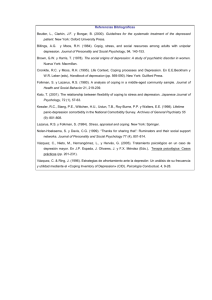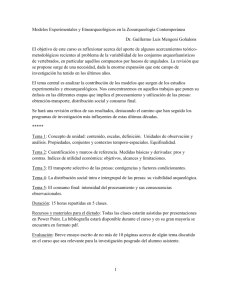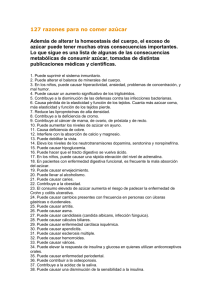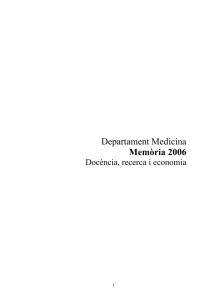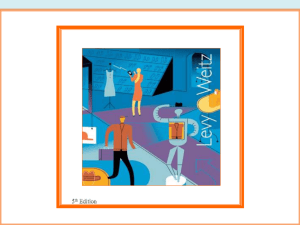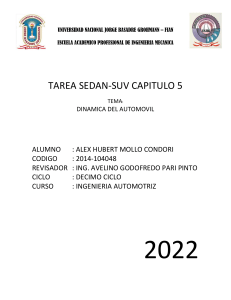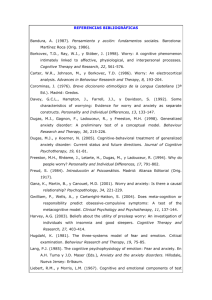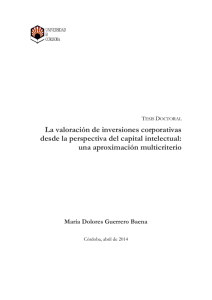Bibliografía del archivo
advertisement
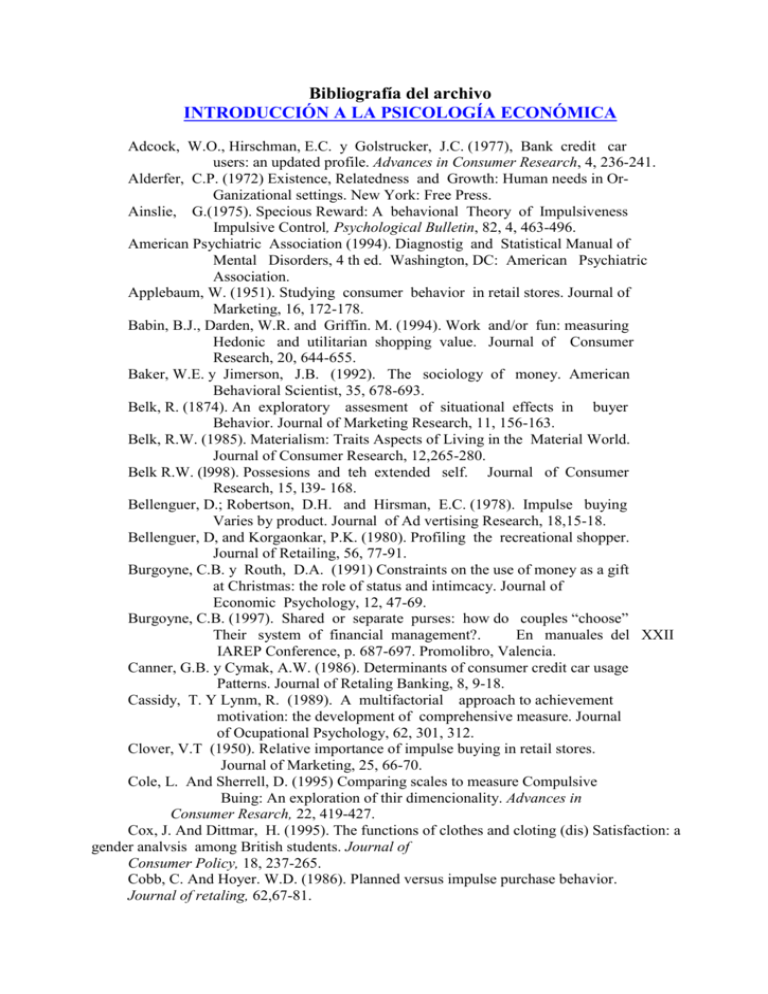
Bibliografía del archivo INTRODUCCIÓN A LA PSICOLOGÍA ECONÓMICA Adcock, W.O., Hirschman, E.C. y Golstrucker, J.C. (1977), Bank credit car users: an updated profile. Advances in Consumer Research, 4, 236-241. Alderfer, C.P. (1972) Existence, Relatedness and Growth: Human needs in OrGanizational settings. New York: Free Press. Ainslie, G.(1975). Specious Reward: A behavional Theory of Impulsiveness Impulsive Control, Psychological Bulletin, 82, 4, 463-496. American Psychiatric Association (1994). Diagnostig and Statistical Manual of Mental Disorders, 4 th ed. Washington, DC: American Psychiatric Association. Applebaum, W. (1951). Studying consumer behavior in retail stores. Journal of Marketing, 16, 172-178. Babin, B.J., Darden, W.R. and Griffin. M. (1994). Work and/or fun: measuring Hedonic and utilitarian shopping value. Journal of Consumer Research, 20, 644-655. Baker, W.E. y Jimerson, J.B. (1992). The sociology of money. American Behavioral Scientist, 35, 678-693. Belk, R. (1874). An exploratory assesment of situational effects in buyer Behavior. Journal of Marketing Research, 11, 156-163. Belk, R.W. (1985). Materialism: Traits Aspects of Living in the Material World. Journal of Consumer Research, 12,265-280. Belk R.W. (l998). Possesions and teh extended self. Journal of Consumer Research, 15, l39- 168. Bellenguer, D.; Robertson, D.H. and Hirsman, E.C. (1978). Impulse buying Varies by product. Journal of Ad vertising Research, 18,15-18. Bellenguer, D, and Korgaonkar, P.K. (1980). Profiling the recreational shopper. Journal of Retailing, 56, 77-91. Burgoyne, C.B. y Routh, D.A. (1991) Constraints on the use of money as a gift at Christmas: the role of status and intimcacy. Journal of Economic Psychology, 12, 47-69. Burgoyne, C.B. (1997). Shared or separate purses: how do couples “choose” Their system of financial management?. En manuales del XXII IAREP Conference, p. 687-697. Promolibro, Valencia. Canner, G.B. y Cymak, A.W. (1986). Determinants of consumer credit car usage Patterns. Journal of Retaling Banking, 8, 9-18. Cassidy, T. Y Lynm, R. (1989). A multifactorial approach to achievement motivation: the development of comprehensive measure. Journal of Ocupational Psychology, 62, 301, 312. Clover, V.T (1950). Relative importance of impulse buying in retail stores. Journal of Marketing, 25, 66-70. Cole, L. And Sherrell, D. (1995) Comparing scales to measure Compulsive Buing: An exploration of thir dimencionality. Advances in Consumer Resarch, 22, 419-427. Cox, J. And Dittmar, H. (1995). The functions of clothes and cloting (dis) Satisfaction: a gender analvsis among British students. Journal of Consumer Policy, 18, 237-265. Cobb, C. And Hoyer. W.D. (1986). Planned versus impulse purchase behavior. Journal of retaling, 62,67-81. Cox, K. (1964). The responsiveness of foof sales to shelf space changes in supermarkets. Journal of Marketing Research, 1, 63-67. Copranzo, R, y Folger, R. (1991). Procedural justifice and worker motivation. En R.M. Steers y L. W. Porter (Eds.). Motication and work behavior. New York; McGraw-Hill, Co. Davies, E. y Lea, E.G. (1995). Student attitudes to student debt. Journal of Economic Psychology, 16, 663-679. d’ Austos, A. & Tremblay, S. (l998). The compulsive side of “normal” consumers. An empirical study. In: G.J. Avlonitis, N.K. Papavasiliou, & A.G. Kouremenos (Eds.). Marketing thought and practice in the 1990’s. Vol. 1, pp. 657- 669. Athens: The Athens School of Economics and Business Science. d’Austos, A. (1990). An inquiry into the compulsive side of “normal” Consumers, Journal of Consumer Policy, 13, 15-31. Delval, J. y Echeita, G. (1991) La comprensión en el niño del mecanismo de intercambio económico y el problema de la ganancia. Infancia y Aprendizaje, 54, 71-108. Delval, J. (1994) Stages in the child's construction of social knowledge. En: M Carretero y J.F. Voss (Eds.) Cognitive and instruccional processes in history and the social sciences. Hillsdales. N.J. Lawrence Erlbaum Associates, 77102. Denegri, M. (1995a) El desarrollo de las ideas acerca de la emisión monetaria en niños y adolescentes: Estudio exploratorio. Revista del Instituto de Ciencias de la Educación, Nº 9, Enero-Abril, 47-62.. Denegri, M. (1995b) El desarrollo de las ideas acerca del origen y circulación del dinero: un estudio evolutivo con niños y adolescentes. Ediciones Universidad Autónoma de Madrid. España. ISBN: 84-7477-555-8. Denegri, M., Delval, J. Ripoll, M. Palavecinos, M. Keller, A.(1998) Desarrollo del pensamiento económico en la infancia y adolescencia. Boletín de Investigación Educacional. Vol. 13. Pg. 291-308 Denegri, M. Keller, A Palavecinos, M. Ripoll, M. Delval, J. La construcción de representaciones sociales acerca de la pobreza y desigualdad social en la infancia y adolescencia. Psykhe, 1998, Vol.7 p. 13-24. Denegri, M., Palavecinos, M., Ripoll,M. (En prensa) Consumir para vivir y no vivir para consumir. Ediciones Universidad de La Frontera. Enesco,I., Delval, J., (1995) La comprensión de la organización social en niños y adolescentes. Madrid. C.I.D.E. Deshpande, R. Y Krishman, S. (1980). Consumer impulse purchase and credit card usage. An empirical investigation using the log linear model. Advances in Consumer Research, 7, 792-795. Desmonde, W.H. (1953). “Anal origin of money”. American Imago, 10, pp. 375378. Darden, W.R. and Reynolds, F.D. (1971). Shopping Orientationes an product usage rates. Journal of Marketing Research, 8, 505-508. Dittmar, H. (1992). The social psycology of material possesions: to have is to be. Harvester Wheatsheaf: St. Martin’s Press. Exeter, UK. Dittmar, H., Beattie, J. and Friese, S. (1995). Object, decisión consideration and Self-image in men’s and women’s impulse purchases .IAREP Conference, Bergen, Norway. Donovan, R. And Rossiter. J. (1982). Store atmosphere: an environmetal psy- Chology approach. Journal of Retailing, 58, 34-57. Doyle, K.O. (1992). Introduction: Money and behavioral sciences. American Behavioral Scientist, 35, 641-657. Doyle, K.O. (1992). Toward a Psychology of Money. American Behavioral Scientist, 35, 708-724. Faber, R.J., O’Guin. T. And Krych, R. (1987). Compulsive comsuption. In: M. Wallendorf and P. Anderson (Eds.), Advances in Consumer Research. Faber, R.J. and O’Guin, T.C. (1998). Disfunctional consumer socialization: A Search for the roots of compulsive buying. Paper presented at the 13 th Annual Colloquium of the International Association for Research in Economic Psychology. Leuven. Belgium, September. Faber, R.J. and O’Guinn, T.C.(1989). Classifying Compulsive Consumers: AdVances in the development of a diagnosti tool. In Advances in Consumer Research. Vol. 16, ed. Melanie Wallendorf amd Paul F.Anderson, Provo, UT: Association for Consumer research, 97-109. Faber, R.J. and O’Guinn, T.C. (1992). A clinical screener for compulsive buying Journal of consumer Research, 19, 459-469. Faber, R.J., Christenson, G.A., De Zwaan, M. Mitchell, J. (1995). Two forms of Compulsive Consumption: comorbidity of compulsive buying and binge eating. Journal of Consumers Research, 22, 296-304. Fank, M. (1994). The development of a money- handling Inventory. Personality and Individual Differences, 17, 147-152. Finn, D.R. (1992). The meaning of money. American Behavioral Scientist, 35, 658-668. Foa, U.G., Converse, J., Tomblom, K.V. y Foa, E.B. (1993). Resouce theory: Explorations and applications. San Diego: Harcourt Brace Jovanovich. Freud, S. (1949). “Character and Anal Eroticism” Colelcte Papers, Vol. II. London: Hoart Press. Friedlander, F. (1963). Underlying sources of job satisfaction. Journal of Aplied Psychology, 47, 246-250. Frisby, D., 1984. George Simmel. Fondo de cultura económica México. Furnham, A. (1984). Many sides of the coin: the coin: the psychology of money usage. Personality and Individual Differences, 5, 501-509. Furnham, A., Kirkcaldy, B.D. and Lynn, R. (1994). National actitudes to Competitiveness, money, and work among young people: First, second And third world differences. Human Relations, 47, 119- 132. Gardner, M.P. (1985). Mood States and Consumer Behavior. A criticla review. Journal of Consumer Research, 12, 281-300. Godwin. D.H. (1997). Dinamics of households’ income, debt, and attitudes Toward credit, 1983-1989. The Journal of Consumer Affairs, 31, 2,303325. Goldberg, H., y Lewis, L. (1978). Money nadness: The psychology of saving, Spending, loving and hating money. New York William Monrrow. Goldenson, R.M. (1984) Longman Dictionary of Psychology and Psychiatry. New York: Longman. Gordon, J.R.(1993). A diagnostic approach to Organizational Behavior. Allyn And Bacon. Greenberg, J. (1987) Reactions to precedural injustice in payment distributions: Do the means justificy the ends?. Journal of Applied psychology, 72, 5561. Hagedorn, L.S. (1996). Wage equity and female faculty job satisfaction. the role of wage differentials in a job satisfaction causal model. Research in Higher Education, 37, 569-598. Hanley, A. y Wilhelm, M.S. (1992). Compulsive Buying: an exploration into Self-esteem and money attitudes. Journal of Economic Psychology, 13,518. Haroaka, K; (1990). Attitudes toward money and value orientations. Procedings Of Japaanese Society of Social Psychology 134-135. Heneman, R.L. (1992). Merit Pay. Reading, MA: Addison- Wesley. Herzberg, F., Mausner, B. Y Snyderman, B.B. (1959). The motivation to work. New York: Wiley. Hills, F.S., Bergmann, T.J. y Scarpello, V.G. (1194). Compensation decisión Making (2 edicion). Fort Worth, TX: The Dryden Press. Hirschman, E.C. y Goldstucker, J.L. (1978). Bank credit card usage in Deparment stores: an empirical investigation. Journal of Retailing, 54, 312. Hirschman, E.C. (1979). Differences in consumer purchase behavior by credit Card payment system. Journal of Consumer Research, 6, 58-66. Hirschmann, E.C. & Holbrook, M. (1982). Hedonic Consumption: Emerging Concepts, Methods, and propositions. Journal of Marketing, 46, 92-101. Hirschmann, E.C. (1983). Predictors of self-projection, fantasy Fulfillment and Escapism. Journal of Social Psychology, 120, 63-76. Hoelzl, E. (1997). Influence in eveyday conflicts between partners. En manuales Del XII IAREP Conference, p 726. Promolibro, Valencia. Hoch, S and Loewenstin, G.F. (1991). Time inconsistent preferences and consumeer self-control. Journal of Consumer Research, 17, 492-507. James, T.A. y Tang, T.L.P. (1996). Downsizing and the impact on survivors: a matter of justice. Employment Relation Today, 23, 33-41. Kasser, T. y Ryan, R.M. (1993). A dark side of the American Dream: correlates of financial success as a central life aspiration. Journal of Personality and Social Psychology, 65, 410-422. Katona, G. and Mueller, E. (1995). The Dynamcis of Consumer Reactions, New York: New York University Press. Kirchler, E. (1997). Household decision over year. First Results of the coupleDecision-diary study. En manuales del XII IAREP Conference, p. 724. Promolibro, valencia. Kollat, D.T. and Willet, R.P. (1967). Consumer Impulse Puchasing Behavior. Journal of Marketing Research, 4, 21-31. Kollat, D.T an Willet, R.P. (1969). Is impulsive Puchasing really a useful Concept in marketing desisions?. Journal of Marketing. 33, 79-83. Ketler, P. (1974). Atmospherics as s marketing tool. Journal of Retailing, 49, 48-64. Lawler, E.E. (1971), Pay and organizational effectiveness: A psychological View. New York: McGraw-Hill. Lawler, E.E. (1981). Pay and organization development. Reading, MA: Addison-Wesley. Lea, S.E., R.M. Taarpy of Economic Psychology. Cambridge University Press. New York. Lea, S.E.G., Webley, P. Y Levine, R.M (1993). The economic psychology of Consumer debt. Journal of Economic Psychology, 14, 85-119. Lea, S.E.G., Webley, P. Y Walker, C.M. (1995). Psychological factors in Consumer debt: money mangement, economic socializacion and credith Use. Journal of Economic Psychology, 16, 681-701. Lejoyerx, M., Tassain, V., Solomon, J. and Ades, J. (1997). Study of Compulsive Buying in depressed patients. Journal of Clinical Psychiatry, 58, 169-173. Lesieur, F.G. y Puckett, E.S. the Scanlon Plan has proved itself. Harward Bisiness Review, 47, p. 109-118. Lesser, J.A. and Kamal, P. (1991). An inductively derived model of the Motivation to shop. Psychology & Marketing, 8, 177-196. Levy, S.J. (1959). Symbols for sale. Harvard Business Review, 37, 117-124. Levy, S.J. (1981). Interpreting Consumer Mythology: A structural approaach to Consumer behavior. Journal of Marketing, 45, 49-61. Lewis, A and Mackenzie, C. (1997). Moral, motives and money: the case of UK Ethical investing. Paper presented to the XII IAREP Conference, Valencia, Spain. Livingstone, S. Y Lunt, P.K. (1992). Predicting personal debt and debt Repayment: Psychological, social and economic determinants. Journal of Economic Psychology, 13, 111-134. Locke, E.A., Ferem, D.B., McCaleb, V.M., Shaw, K.N., y Denny, A.T. (1980), The relative effectiveness of four methods of motivating employee Performance. En: Ducan, K.D., Gruneberg, M.M. y Wallis, D. (edit), Changes in Working life, pp. 363-388. Chichester, England: John Wiley. Luft, J. (1957). Monetary value and the perception of persons. The Journal of Social Psychology, 46. 245-251. Luna –Arocas, R. (1995). Los estilos de compra y la satisfacción del consumidor En el contexto de la Psicología Económica. Tesis Doctoral Universidad De Valencia. Luna-Arocas, R., I. Quinatnilla y R. Díaz (1995). Psychology of money: attitudes And perceptions within young people. IAREP Conference. Institut of Marketing. Bergen, Norway. August 2nd-5th. Luna-Arocas, R., Quintanilla, 1. And Berenguer, G. (1998). La compra compulSiva y la compra patológica: el modelo CAC. IVIE, Working Papers-11. Luna-Arocas, R. y Quintanilla. I (1998). Atttitudes toward money: influence in Comsumption patterns. En revisión. Luna-Arocas, R. and Tang, T.L. (1998). La psicología económica del dinero: De la escala ética del dinero (MES) y la escala de actitudes hacia el dinero (EAD-6). En revisión. Luna-Arocas, R; Tang, T.L. y Guzmán, G. (1998). La psicología económica del dinero en el contexto de los Recursos Humanos. II Congreso Iberoamericano. Madrid. España Luna-Arocas, R. y Tang. T.L. Money Ethic and Job Satisfaction: USA vs Spain. 24th International Congress of Applied psychology, IAAP. August, 1998. San Francisco. USA. Martinez-Salinas, E. (1997). Fanily behaviour in the decision making process: Husband-wife influence. En manuales del XII IAREP Conference, p 698723. Promolibro, Valencia. Maslow, A.H. 81987). Motivation and Personality. New York: Harper& Row. Third Edition. Mason, J.W. (1992). Meaning of money: A financial planning and counseling Perspective. American Behavorial Scientist, 35, 771-780. Mathis, R.L. y Jackson, J.H. (1997). Human Resource Management. 8 Edicion. West Publishing Company. McClelland, D.C., Atkinson, J.W., Clark, R.A y Lowel. E. L. (1953) The Achievement Motive. New York: Appleton. Miller, D. (1998). A thory of shopping. Cornell University Press. Mischel, W. Theory and research on the antecedents of self-imposed dealy of Reward. In B.A. Maher (Ed), progress in experimental personality Reseaech. Vol.3. New York: Academic Press. 1966. Mischel, W. Coates, B. and Raskoff S.A. (1968) Effects of success and failure self- gratifications. Journal of Personality and Social Psychology, 10, 381-390. Mischel, W. And Ebbesen, E.B. (1970) Attention in delay of gratification. Journal of Personality and Social Psychology, 16, 329-337. Mischel, W., Ebbesen, E.B., and Raskoff, A. (1972). Cognitive and attentional Mechanisms in delay of gratification. Journal of Personality and Social Psycology, 21, 204-218. Nataraajan, R. and Goff, B.G. (1992). Manifestations of Compulsiveness in the Consumer-Marketplace domain. Psychology & Marketing, 9, 31-44. Needleman, J. (1991). El dinero y el sentido de la vida. Ediciones Temas de Hoy. O’Guinn, T.C. and Faber, R.J. (1989). Compulsive Buying: A Phenomenological exploration. Journal of Consumer Research, 16, 147-157. O’Guinn, T.C. and Belk, R.W. (1989). Heaven on Earth: Consumption at Heritage Village, USA. Journal of Consumer Research, 16, 227-238. Pahl, J. (1995). His money, her money: recent research on financial organisation In marriage. Journal of Economic Psychology, 16, 361-376. Park, C,W., Iyer, E.S. and Smith, D.C. (1989). The effects of situational factors On in-store grocery shopping behavior: the role of store environment an Time available for shopping. Journal of Consumer Research, 15, 422-433. Patterson, L.W. (1963). In-store traffic flow, New York: Point-of-Purchasing Advertising Intitute. Paz Moreno F.; (1991). ¿El dinero? – Cuadernos de Antropología.Ed. Antropohos Peele, S(1979). Redefining addiction II. The meaning of addiction in our lives. Journal of Psychedelic drugs, 11, 249-297. Pollay, R. (1968). Customer impulse purcharsing behavior.Journal of Marketing Research, 5,323-325. Prince, M. (1993). Self-concept, money belief and values.Journal of Economic Psychology, 14, 161-173. Prince, M. (1993). Women, men and money styles. Journal of economic Psychology, 14, 175-182. Quintanilla, I. (1989). Psicología y Marketing. Evaluación de la conducta del consumidor. Ed. Promolibro. Valencia. Quintanilla, I. (1999). “El consumo en la sociedad valenciana”. Cap.X.5 en la Comunitat Valenciana en L’Europa Unida. Generalitat Valencia. Quintanilla, L, (1997). Psicología Económica: Fundamentos teóricos. Ed.McGraw-Hill. Richins, M.L. and Dawson, S. (1992). A consumer values orientations for mateRialism and its measurement: scale development and validation. Journal of Consumer Research, 19,303-315. Rim, (1982). Personality and attitudes concerning money. Paper presented at the Seventh international symposioum on economic psychology. Edinburgh. Robert, J.A. and Martinez, C.R. (1998). The emerging consumer in México: an exploratory investigation of Compulsive Buying in Mexican young adults. Journal of International Consumer Marketing, 10, 12. Rodler, C. (1997). Influence tactics in everyday conflicts (Vienna Diary Study). En manuales del XII Iareo Conference, p. 725. Promolibro, Valencia. Rogers, B.L. y Schlossman, N.P. (1990). Intra-household resource allocation: Issues and methods for development, policy an planning. Tokyo: United Nations University Pres. Rook, D. And Hoch, J. (1985). Consuming impulses. In Advances in Consumer Research, 23-27. Rook, D.W. (1987). The buying Impulse. Journal of Consumer Reasearch, 14, 189-199. Rosemberg, M. (1965). Society. And the adolescent self-image. Princeton, NJ: Princeton University Press. Rubinstein, C. (1981). Money & self-esteem, relationship, secrecy, envy, Datisfation. Psychology today, 15 (5), 29-44. Scherhorn, G., Reisch, L.A. and Raab, G. (1990). Addictive Buying in West Germany: an empirical study. Journal of Consumer Policy, 13, 155-189. Scherhorn, G. (1990). The addictive trait in buying behavior. Journal of Consumer policy,13, 33-51. Simmel, G., (1958). Filosofía del diner. Instituto de Estudios Políticos. Madrid. Skoien, D. (1997). “Report reveals Worker motivation, commitment, skills,...”. IPMA News December. Pag. 23. Smith, P.C., Kendall, L.M., y Hulin, C.L. (1975), The measurement of Satisfaction in work and retirement. Bowling Green, OH: Bowling Green State University. Stern, H. (1962). The significance of Impulse Buying Today. Journal of Marketing, 26, 59-62. Tang, T.L.P. (1992). The meaning of money revisited. Journal of Organizational Behavior, 13, 197-202. Tang, T.L.P. (1993). The meaning of money: Extension and exploration of the Money Ethic Scale in a sample of university students in Taiwan. Journal Of Organizational Behavior, 14, 93-99. Tang, T.L.P. (1995), The development of a short Money Ethic Scale: Attitudes Toward money and pay satisfaction revisted. Personality and Individual Defferences, 19, 809-817. Tang, T.L.P. (1996). Pay diferentials as a function of rater’s sex, money ethic, And job incumbent’s sex: A test of the Matthew Effect. Journal of Economic Psychology, 17, 127-144. Tang, T.L.P., y Gilbert, P.R. (1995). Attitudes toward as related to intrinsic and extrinsic job satisfaction, stress, and work-related attitudes. Personality and Individual Differences, 19, 327-332. Tang, T.L.P., y Tang T.L.N. 81996). Attitudes toward money, intrinsic job Satisfaction, and voluntary turnover. In C. Roland-Levy (Ed.), Proceedingsm of the 21st Annual Colloquium of the International Association for Research in Economic Psychology, Social & economic Representations,1: 410-420. Paris, France. Tang, T.L.P. y Baldwin, L.J. (1996) distributive and procedural justice as related Tod to satisfaction and Commitment. SAM Advanced Management Journal, 61, 25-31. Tang, T.L.P.., y Weatherford, E.J (1997, March) Secondary vocational business Students’ ethical decision marking. Paper presented at the International Conference of the Academy of Human Resource Development, Atlanta, GA. Tang, T.L.P., y Whiteside, H.D. (1997, April). Money attitudes among university Faculty: The new Money Ethic Scale. Paper presented at the 43rd Annual Meeting og the Southwestern Psychological Association, Fort Worth, TX. Tang,T.L. y Luna-Arocas, R. (1998). Money as motivator and the Endorsement Of the money ethic among University faculty in the USA and Spain: The Development of a new money ethic scale. En revisión. Tauber, E.M. (1972). Marketing notes and comunications: Why do people shop? Jornal of Marketing, 36, 46-59. Tokunaga, H. (1993). The use and abuse of consumer credit: application of Psychological theory and research. Journal of Economic Psychology, 14, 285-316. Valence, G., d’Astous, A. and Fortier, L. (1988). Compulsive Buying: concept and measurement. Journal of Consumer Policy, 11, 419-433. Vogler, C. y Pahl, J. (1993). Social and economic change and the organization of Money in marriage. Work, employment and society, 7, 71-95. Wahba, M.A. y Bridwell, L.G.(1973). Maslow Reconsidered: a reviewiew of Research on the need hierachy theory. Proceedings of the thirty-third anNual meeting of the Academy of Management, pp. 514-520. Wallendorf, M. And Arnould, E.J. (1988). “My favorite things”: a cross-cultural Inquiry into objects attachment, possessiveness and social linkage. Journal of Consumer Researcha, 14, 531-547. Weber, M. (1904). The. Protestant Ethic and the Spirit of Capitalism. New York: Scribner. Webley, P., S.E.G. Lea, y R. Portalska, The unacceptability of money as a gift. Journal of Economics Psychology, 4, 223-238. Webley, P., Lea, S.E.G. y Portalska, R (1983). The unacceptability of money as A gift. Journal of Economic Psychology, 4, 223-238. Webley, P. Y Wilson, R. (1989): Social relationships and the unacceptability of Money a grift. The Journal of Social Psycology, 129, 85-91. Welbourne, T.M. y Gómez- Mejía, L.R. (1995). Gainsharing: a critical review And a future research agenda. Journal of Management, 21, 559-609. Werminont, P. y S. Fitzpatrick, (1972). The meaning of money”. Journal of Applied Psychology, 56, 218-226. Weinberg, P and Gottwald, W. (1982). Impulsive cbuying as a result of emotions. Journal of Business research, 10, 43-57. West, J.C. (1951). Results of two years of study into impulse buying. Journal of Marketing, 15, 362-363. Westbrook, R.A. and Black, W.C. (1985). A motivation- based shopper typology. Journal of Retalling, 61, 1, 78-103. Willey, J.B. y Richard, L.M. (19749. Application of discrimiant analysis in for- Mulating promotional strategy for bank credit cards. Advances in Consumer Research, 2, 535-544. Winstion, G.C. (1980). Addiction and backsliding. A theory of compulsive consuption. Journal of EconomicBehavior and Organization, 1, 295-324. Wolman, B. (1973). Dictionary of bahavioral Science. New York: Van NosTrand Reinhold. Woods, W.A. (1960). Psychological dimensions of consumer decisions. Journal Of Marketing, 24, 15-19. Wroom, V.H. (1964). Work and Motivation. New York: Viley. Yamauchi, K.T. and D.J. Templer, (1982). The development of a money attitude Scale. Journal of Personality Assesment, 46, 522-528. Zelizer, V.A.,(1989). The social meaning of money “special monies”. American Journal of Sociology, 95, 342-77. Subir
